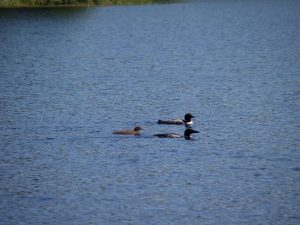
LOONS DECREASE
Researchers are saying that the loons’ reproductive success has declined since the 1960s and that decrease correlates directly with the quality of water in the Great Lakes.
“Loons are really good indicators of the health of the aquatic ecosystem,” said Kristin Bianchini, a researcher at Birds Canada and Acadia University, Wolfville, Nova Scotia. “They are top level predators, so if there are any contaminants in the water it directly affects them.” Bianchini is the lead author of a new study of this problem published in the journal Science and the Total Environment. The major culprits are acid rain, mercury and a changing climate.
Acid rain contains sulfuric or nitric acid which changes the pH level of the lake and harms fish and wildlife by reducing their numbers. At a lower pH fish can’t survive and eggs don’t hatch. Acid rain also accelerates the mercury content of fish which, after consumption then accumulates in the loons’ tissues and alters their behavior. All of this is compounded by other forms of pollution and lead poisoning still in sediment. Adult loons basically abandon their nests.
“The mercury in the lakes makes the loon parents lethargic and they abandon their chicks. This isn’t normal because loons typically are great parents and have a strong parental instinct,” said Bianchini.
Studies have shown that the pH levels are improving but there is still a lot of mercury in fish. Birds Canada speculates that it takes decades to remove acid rain and mercury and the populations that were eliminated have yet to recover.

Waterbird Biologist Dave Moore of the Canadian Wildlife Service, Ottawa, said that during the last two years he has seen botulism increasing in the loon population “which is something new.”